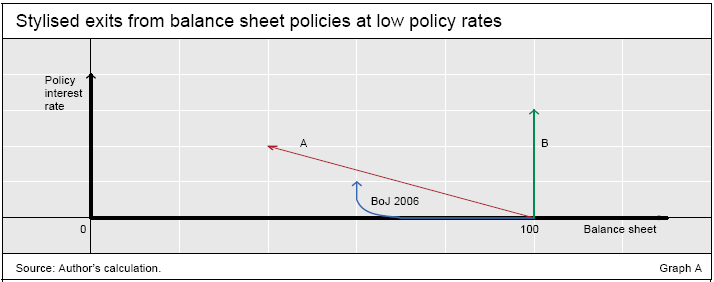Exiting from balance sheet policy of central banks
(Extract from pages 6-7 of BIS Quarterly Review, September 2009)
With market conditions improving, discussion has turned to when, and how, central banks will tighten monetary policy and whether this will involve a disposal of the assets accumulated during the crisis to keep markets functioning and to affect asset prices ("balance sheet policy"). In principle, these decisions can be taken independently. As the BIS 79th Annual Report, Chapter VI, points out, central banks can raise policy rates and reduce excess reserves without shrinking their balance sheets, provided they have an adequate set of tools at their disposal.
This box focuses on the factors conditioning the sequence of these two decisions. The two extreme cases are: working down the balance sheet and only then raising interest rates; and raising interest rates without shrinking the balance sheet. These cases can be represented as a move left then up, or a move straight up in the graph of balance sheet size (indexed to 100 at the highwater of balance sheet policy on the x-axis) and interest rate (starting at zero on the y-axis). It should be recognised that asset reductions carry different implications (and changes in composition of assets as well as their size can be important).
At one extreme, the Bank of Japan (BoJ) in 2006 shrank its balance sheet before it raised policy interest rates. Without the authority to pay interest on excess reserves, the BoJ stopped replacing maturing assets in the months after March 2006.1 "Current accounts", or bank reserves, fell from ¥31 trillion at end-March 2006 to about ¥10 trillion by mid-June and total BoJ assets fell even more, from ¥145 trillion to ¥113 trillion on 20 June. This balance sheet reduction, along with the reopening of interbank credit lines and the introduction of trading in forward overnight interest rates, prepared market participants for the July rise in the short-term interest rate. Graph A shows a leftward move along the x-axis at zero interest rates, and then a return to positive interest rates. Running off assets in this manner depended on careful limits on long-term bond holdings,2 and on the term of money operations. Interestingly, the BoJ continued, after this exit from excess reserves and return to positive interest rates, to buy bonds every month.
The BoJ's focus on its liabilities may limit the force of this precedent for how to exit from a low-interest high-asset situation. In the Japanese case, which assets were acquired to support central bank liabilities was portrayed as incidental and the choice of short-term assets permitted a rapid but passive run-down. The Bank of England and the Federal Reserve, purchasing bonds in order to lower long-term rates, and the Swiss National Bank, purchasing foreign exchange to hold down the Swiss franc, find themselves in different positions from the BoJ.
In these cases, various considerations will bear on the choice of exit path, including market functioning, prices and reaction, as well as the run-off of any short-term assets. Somewhat overlooked, different concepts of balance sheet policy - stock versus flow - may also condition the path chosen. On a stock view, monetary stimulus is seen as arising from the central bank's holding of assets like government or other bonds. On a flow view, monetary stimulus arises from the central bank's purchase of assets. From this perspective, stimulus ends when no more purchases are announced and asymmetry may be desired: maximum effect in buying and "neutrality" in selling.
This distinction could become important when the time comes to tighten policy. On the stock interpretation, to raise the short-term interest rate while never selling the bond holdings would be to tap the brake while the other foot remained firmly on the accelerator. On the flow interpretation, without a foot on the accelerator, one could consistently tap the brake. Thus, the stock concept would be consistent with a tightening path like vector A in the graph (or even a path like that of the BoJ), while the flow concept would permit a tightening path like vector B in the graph.
The Bank of England's policies have arguably been based on the stock view of balance sheet policy. In particular, its rationale for gilt purchases to reach an eighth of GDP included the quantity of broad money. The Bank of England has made clear that when the inflation target requires a withdrawal of monetary stimulus, it would have two tools: hikes in the policy rate and asset sales. Sales of Bank of England bills could absorb liquidity, "allowing us to stagger the sales of the gilts".3 In response, market analysts are couching their forecasts of policy in terms of both rises in the short-term interest rate and gilt sales.
In contrast, statements from the Federal Reserve tend to view the monetary stimulus arising from its $1.75 billion in bond purchases mainly in flow terms. Looking forward, the difficulty of calibrating the restraining effect of bond sales in view, inter alia, of financial firms' evolving balance sheet constraints and risk appetite may argue against bond sales. That said, the Federal Reserve has signalled that it will not necessarily exit along a vertical vector like B. Able (like the Bank of England) to pay interest on excess reserves, the Federal Reserve could quit purchasing bonds and raise interest rates without shrinking its assets.4 Or excess reserves could be absorbed without asset sales through short-term repo transactions against long-term securities or an extension of the Treasury's selling bills in excess of its borrowing requirements and depositing the proceeds with the Federal Reserve. Among the options listed, albeit mentioned last, were bond sales.
The Swiss National Bank has offered little guidance on its exit from its policy of purchases of foreign assets to resist currency appreciation. Conceptually, some recent studies of foreign exchange intervention focus on the effect on order flows, while the portfolio balance approach emphasises the relative size of stocks. Behaviourally, there are instances where central banks have reduced official foreign exchange reserve holdings after a series of purchases, but more cases like that of Japan since 2004, in which holdings remain at levels reached as a result of intervention. Recent experience in borrowing dollars from both the Federal Reserve and the market will factor in any reconsideration of the appropriate level of Swiss foreign exchange reserves.
In addition to the above factors, political economy considerations may also condition the exit path chosen. The Bank of England's asset purchases were capped ex ante by an exchange of letters with the UK Treasury, held in a special account and supported by a government indemnity against losses should interest rates rise. These arrangements allow the Bank of England to sell gilts without loss to its own limited equity so that these considerations might not be relevant. With less formal coordination of its asset purchases with the US Treasury, either as recipient of its profits or as debt manager, these considerations may be relevant for the Federal Reserve.
1 Alternatively, the BoJ could have issued central bank bills to mop up liquidity, thus exchanging two types of liabilities while leaving assets unchanged.
2 Bank of Japan, Financial Markets Department, "Money market operations in fiscal 2006", BoJ Reports and Research Papers, July 2007; on bond purchases, "Government debt management at low interest rates", Quarterly Review, June 2009.
3 Deputy Governor Bean speech at Cutlers' Feast, Cutlers' Hall, Sheffield, 21 May 2009. On 21 July 2009, Bean was quoted as follows in the Nottingham Evening Post: "It is quite likely we will in the first instance raise bank rate. We can then start selling the assets we have bought at a rate which recognizes the market circumstances at the time."
4 "Monetary policy as the economy recovers", in Board of Governors of the Federal Reserve System, 2009, Monetary Policy Report to the Congress (Washington: Board of Governors, July), pp 34-7.


